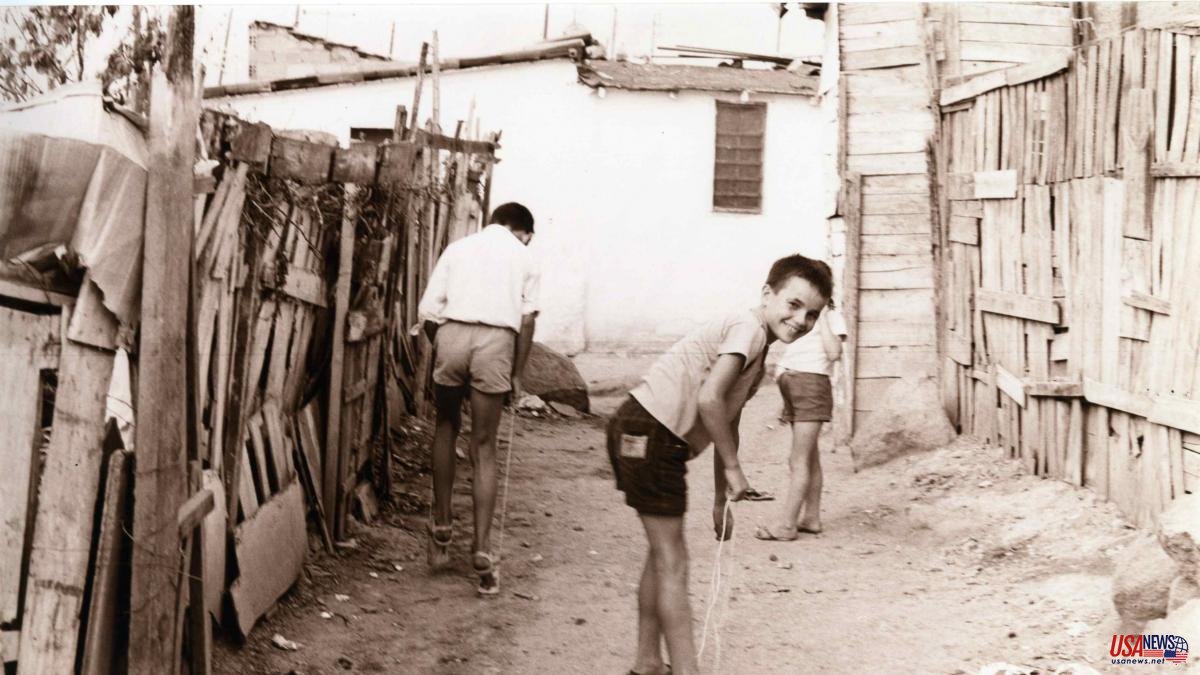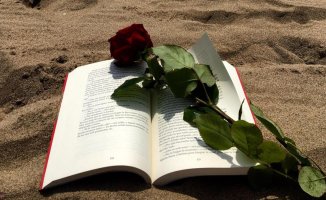«August 15, 1971 is the most important day of my life. The day of the Watusi. The arch that stretches over the dawn when Pepito and I, sheltered from the rain by blue plastic, fish on a collapsed dam, and the rainy dawn of the next day ends ingloriously. Events have brought us back to the same place…”
Next Monday, August 15, is the day of the Watusi, that is, the day of the year 1971 in which a decisive part of the action of 'The day of the Watusi' by Francisco Casavella (1963-2008) takes place. Every year, fans of this cult novel carry out -not only in Barcelona, but also in other cities, such as León- events of various kinds to commemorate the book in the manner of a suburban Bloomsday, with activities ranging from routes through the stages, wild dances with lysergic DJs, letters 'w' that appear painted on the streets, animation on social networks, picnics and even ad hoc tattoos.
Although the current edition of Anagrama consists of a single volume, the work was originally published in three installments, 'The fierce games' (2002), 'Wind and jewels' (2002) and 'The impossible language' (2003), which They hit the streets with only a few months between them. In a letter that some cultural journalists received on July 3, 2002, the editor of the Mondadori Literature, Claudio López de Lamadrid, warned us that it was "a monumental novel." It was unusual to receive this type of letter from Claudio, who, infected by the enthusiasm of the agent Carmen Balcells, was also the author of the idea of separating it into three installments -emulating the release of 'Alexandros' by Valerio Manfredi- and to launch it with a billboard and street advertising campaign that included a huge 'W', which flooded Barcelona like the bat sign does with Gotham. It is impossible for a reader of Casavella not to see the current Vela hotel, crowned by a huge W and located right on the beach where some scenes of the novel take place, as a sign that confirms what is narrated in it. After winning the Nadal award in 2008, the work was also published in Destino for the first time in a single volume, a decision by the editor Silvia Sesé, a good friend of the author.
The story, in reality, does not happen only on the aforementioned August 15, but rather accompanies us through the evolution –or not- of Barcelona and the country as a whole from 1971 to 1995, when Fernando Atienza recounts what happened, since he has been commissioned a report, which he writes or reads with constant flashbacks and fast forwards, addressing an anonymous reader.
There is little of a professional report in Atienza's narration, who is involved in the events with great detail and emotion. To begin with, on that frenetic August 15, 1971, he toured the entire city, at the age of 13, together with his friend Pepito el Ye Yé, a gypsy and lame, a contemporary rogue, to warn the mythical Watusi that in the neighborhood he They were looking to make him pay for the rape and murder of Julia, the daughter of one of the local underworld ringleaders. Everything he experienced that day will haunt him for the rest of his life.
The Watusi is a mysterious character with mythological edges. Many stories are told about him: that he is a hired killer, that he has his ethics, that he transforms when he dances wildly… López de Lamadrid referred to him as “king of rhythm, mercenary, guardian of joy and messenger of death ”.
I interviewed Casavella in August 2002, just before the first volume appeared, on a terrace in Plaça Vicenç Martorell. He then told me that his goal was "to draw the failure -or development- of an individual spirit in parallel with the spirit of the country."
The narrated action is clearly police: the murder of a girl, which leads to looking for her murderer in an environment of slums and crime. But the novel transcends that and becomes a portrait of the history of Barcelona and the entire country from late Francoism to the summer of 1995, with political and economic scandals, corruption, the surrender of ideals, and the contrast between the great historical changes and the miserable life of the inhabitants of the neighborhoods, who live with the myth of a prodigious city that they only see on television. That is one of the themes of the book: the invention of reality, in the everyday and in the great, the borders between truth and lies, the omnipresence of imposture. What the motto said that, Casavella said, we should all hang at the head of our beds: "Be careful how you look at the world because the world will be how you look at it." 'The day of the Watusi' also brought to light some neighborhoods that literature had ignored. The author's story is clearly opposed to the euphoria and apology of the Transition and the Olympic Games.
The settings are multiple: the mountains of Tibidabo and Montjuïc (this one, with its shacks that once housed 30,000 people and its now-defunct amusement park), the beaches, the port, the breakwater, the zoo, the Raval brothels and from the upper area, Poble Sec… The vast majority of the denominations that appear in the novel are real, although today not everyone remembers them: El Molino, La Tierra Negra, Las Cuevas de Alí Baba, Ciudad Sin Ley, Las Casitas… “Because Barcelona is so small –the author joked-, one day all the writers of the city met in secret and we divided up the areas in a mafia: for Marsé el Guinardó, you don't write about Carmel, kid... and for me Montjuïc touched me, with all its classic areas: Casa Valero, Casa Antúnez, Los Tres Pinos...” He was “always fascinated by the stories of my neighbourhood, Chino and Poble Sec, their echoes still reach me. Bodies floating in the harbor I haven't seen, no... just shoes. These are things that explain... For these moves to happen to you directly, you have to be very involved in the underworld and believe the mythical of those underworld heroes, like Watusi. If I have met them? Of course, for example, Boots, he was credited with all the things that happened. There was another that... but don't put it, he's still alive and I want to be too. Youth is attracted to the criminal world, but the professionals are not kidding, the further away you are from them, the better.”
This is a single novel, not three that can be read in any order. "It counts as one because I haven't charged it three times," the author pointed out to me. The first part, 'The fierce games', is the one that leads us to that violent day of August 15, 1971 that can only be overcome by inventing the facts, a story that is digestible. 'Wind and jewels' shows a world, that of the mid and late 70s, in which money and political ambition rule: the narrator goes to work in a bank (Casavella was a button at La Caixa) “and he sees involved in the formation of a political party that tries to enter the great formation of the center that is already in sight. It was a time when things happened every day and democracy was shown in a very naïf way, they sold us a film very far from what was really being forged, the passage from one bureaucracy to another”. And, finally, 'The impossible language' narrates the social ascension of an Atienza who finds his refuge in the night, and covers from 1977 to 1995. "The passage from a dramatic country to an idiotic country is told - continued the author -. The narrator has now become a tireless social climber. In the early eighties he entered the world of music, until he ended up in politics again, in those little jobs that are done in the shadows. It is the most reflective volume.” The 'Watusi' goes down to the mines and goes up to the palaces, it shows the Barcelona of those above and those below, the quinquis of the shantytowns but also a businessman suspiciously similar to Javier de la Rosa, who owns the park of attractions of Tibidabo and that he must eat a sandwich in his cell at Modelo prison for Christmas.
Casavella, whose bad nightlife was almost as legendary as that of the Watusi, was actually called Francisco García Hortelano, and died at the age of 45 while working on another novel starring Fernando Atienza. He knew that the Watusi was the best thing he had ever done. “At least once in your life –he told me-, you have to try to make a sacrifice and write something long. I began to write this novel in 1998, after a painful ordeal working on movies for television, and thus I was able to finance the subsequent four years locked up writing. I have written in the morning, in the afternoon and at night. I have given the chest do. I have ended up very stupid, I have been left empty, without neural power, if I ever had it. If you ask me what has happened in these four years, the answer is: I don't know. Before Watusi he had published 'El triumph' (1990), 'Stay' (1993), 'A Spanish dwarf commits suicide in Las Vegas' (1997) and 'The secret of the parties' (1997). After Watusi, 'What I know about vampires' (2008), a historical novel that Nadal won. What difference does it make. They say that it did not have readers, but followers, and this has a single explanation, which begins with 'W' and that it is one of the best novels of the 21st century.













